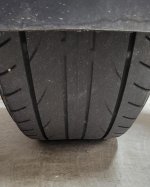And
THAT's why the traction (& tread life) on your Yokohama Advan Fleva v701 205/55 R15 has been so poor, as you've mentioned elsewhere! The Yoko was designed with the capability to carry a car weighing in at over twice the weight of your Spyder's rear end when run @ 28psi, so with half the weight on it, at 28 psi the Yoko was grossly over-inflated, giving you the wear pattern you've shown us; it would never get its tread up to operating temperature (which effectively requires about a 3-4 psi increase in pressure from cold after an hour's riding & you would've had very little pressure increase at all, if any!) so it'd never provide its best possible traction; it would've given you a much harsher ride; it would've been far more rigid than ideal to keep the tread firmly in contact with the road all the time; it would've exposed your tire to excessive wear (particularly in the middle of the tread, only due to over-inflation rather than 'throwing-out' like the OEM Kendas); and the list goes on!
It's the air (& pressure) inside the tire that carries the load on it, and your Spyder is a much lighter load/weight than that of the cars that need 28 psi in that Yoko to carry their weight, so you need less pressure in it to carry the load - and by over-inflating it for the load the way you did may well have given you a very direct & precise feel with little sidewall roll, but Radial Tires are
DESIGNED to have a fair degree of sidewall roll in order to keep their tread surface firmly in contact with the road surface.... that's the big difference between radial & cross-ply tires & how come radials improved ride & handling while significantly increasing traction - only your radial Yoko wouldn't have been able to keep its tread firmly in contact with the road surface, cos the sidewalls that've been made strong enough to carry a heavier load couldn't flex enough at that pressure so it would've forced then to 'lean' rather than flex & you would've been peeling the inside edge of the tread up so that you were running around the corners on the edge of the tread (& probably wearing the tread shoulders 'round' too!

) So yeah, you might find the ride different once you start running your rear tire at a pressure 'more appropriate for the lighter load', but by running the Yoko at a 'more appropriate for the load' pressure of 18 psi, the Yoko should be able to perform
EXACTLY the way it's designed to, instead of riding & gripping the road like a brick in the manner it would've at 28 psi under a Spyder! :yikes:
But I really don't want to type all the rest of this out again - there's a
heap of info already on the Forum about this, it'd pay you to do a bit of searching & spend some time reading it; and reading the reports by many on what must by now add up to literally
millions of miles successfully run by the collected members on these '
more appropriate for the lighter load' lower pressures - Go on, you know you want to, and you might learn something too?! :thumbup:

